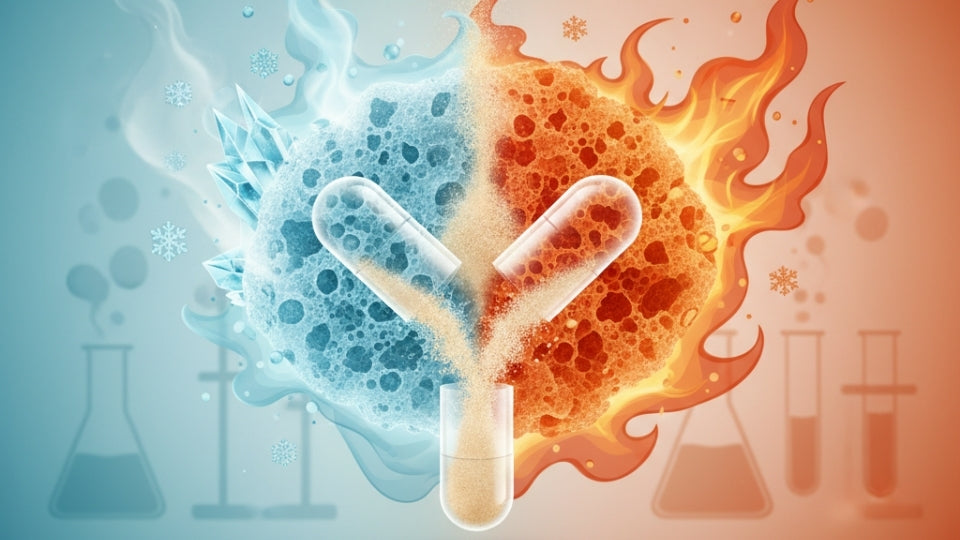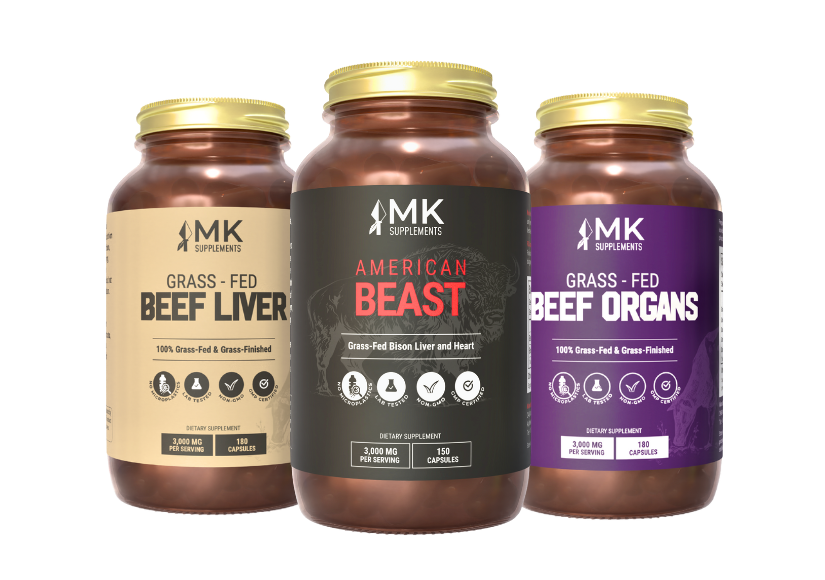
Freeze Drying vs. Heat Drying In Beef Organ Supplements: How Processing Shapes Potency
Michael KummerAt MK Supplements, our mission is to deliver organ meat supplements that capture nature’s full spectrum of vitamins, minerals and proteins. Although both freeze drying and heat drying remove moisture to create stable powders, the two methods differ significantly in their impact on nutrient preservation, texture, and shelf stability.
Read on to explore why our carefully engineered freeze drying process offers superior potency compared to more common and conventional methods.
A Snapshot of Drying Methods
Before diving into the details, here’s a quick comparison of the two primary dehydration techniques used in supplement production:
| Freeze Drying | Heat Drying | |
|---|---|---|
| Mechanism: | Ice → vapor, under deep vacuum | Evaporation at 45–70°C (up to 90°C) |
| Typical cycle time: | 24–72 hours | 6–12 hours |
| Shelf/bed temperature: | -20°C (primary) → 30–40°C (secondary) | 45–70°C (150–158°F) |
| Maximum product temperature: | ≤ 40°C throughout | 60–90°C |
| Structure: | Porous, sponge-like | Some shrinkage, risk of case-hardening |
| Vitamin C retention: | ≥ 90% | 20–60% |
| Fat-soluble vitamins: | ≥ 95% | 30–50% |
| Protein integrity: | Native structure preserved | Partial denaturation |
This table highlights the core differences: freeze drying operates at low temperatures over a prolonged period, gently sublimating ice under vacuum. Heat drying uses hot air at atmospheric pressure to remove moisture more quickly, albeit at the expense of higher heat exposure.
High heat denatures not only proteins but also heat-sensitive micronutrients, such as Vitamin C, B vitamins and CoQ10.
From Harvest to Powder: Our Multi-Step Protocol
Our process begins long before the drying chamber. By combining gentle sanitation, rapid freezing and precise quality controls, we ensure that every organ arrives in the dryer with its nutrients fully intact.
Gentle PAA Rinse and Flash-Freezing
We start at the source: grass-fed, regeneratively-raised cattle and bison harvested under strict welfare and traceability standards.
Immediately after harvest, the organs receive a swift rinse in a food-grade peroxyacetic acid (PAA) solution, which is a biodegradable blend of hydrogen peroxide and acetic acid. This step neutralizes surface microbes without resorting to high-heat scalding or harsh chemicals. By avoiding thermal shock, we protect heat-sensitive B vitamins and digestive enzymes.
Within minutes, the organs are immobilized on dry ice and transferred to a -40°C environment. Rapid freezing halts microbial activity, enzyme breakdown and oxidation, effectively “pausing” the nutrient clock until further processing is complete.
These preparatory steps set the stage for our gentle freeze drying method, which doesn’t require high temperatures as a “kill step.”
Why Freeze Drying Wins When It Comes to Nutrient Preservation
Once frozen solid, our organs enter the freeze dryer, where water removal occurs in two carefully controlled stages:
- Primary drying (sublimation): In a near-airless chamber chilled to -20°C, the ice in the tissue turns straight into vapor instead of melting, leaving behind a light, sponge-like network of tiny pores.
- Secondary drying (desorption): Temperatures are gradually increased to 30–40°C (far below the typical temperature of air-dry ovens) to drive off bound water without damaging fragile vitamins or proteins.
This gentle, non-thermal mechanism translates to extraordinary nutrient retention:
- Vitamin C: Over 90% preserved, thanks to low temperatures and minimal oxygen exposure.
- B-complex vitamins: Losses are typically under 15%, ensuring that the organ’s thiamine, riboflavin and folate remain largely intact.
- Fat-soluble vitamins (A, D, E, K): At least 95% retention, as the vacuum environment prevents oxidative breakdown of carotenoids and tocopherols.
- Proteins and enzymes: The proteins and enzymes stay in their original form, so they remain active just like they would in fresh, raw organs.
The final freeze-dried product is a lightweight, porous cake that grinds easily into a fine powder, ideal for encapsulation.
Why We Don’t Use Heat Drying
In contrast, conventional hot-air drying pushes warm, ambient-pressure air through the material at 45–70°C (and sometimes up to 90°C) for 6–12 hours. While this method offers faster throughput and lower capital costs, it comes with trade-offs:
- Vitamin C degradation: Exposure to heat and oxygen can reduce Vitamin C content by 40–80%, depending on temperature and drying duration.
- Oxidation of carotenoids and Vitamins A/E: Provitamin A losses can approach 80%, and tocopherols may drop by 15–36%, altering color and antioxidant capacity.
- Protein denaturation: The high heat essentially “cooks” the tissue, partially denaturing proteins and enzymes, and causing irreversible changes that affect both functionality and texture.
- Textural changes: Heat-dried powders can exhibit case-hardening (a hard outer shell) and less uniform particle size, making milling and mixing more challenging.
Heat-dried organ powders still supply valuable nutrients but cannot match the potency and “raw” profile of freeze-dried counterparts.
The Bottom Line
While heat drying offers speed and cost advantages, it inevitably sacrifices some nutrient integrity through thermal and oxidative degradation. In contrast, MK Supplements’ vacuum-assisted freeze drying – coupled with our PAA wash, flash-freeze kill step and premium grass-fed starting materials – maximizes the retention of vitamins, minerals and raw-food bioactives.
The result? Organ supplements that are as potent and pure as nature intended.
We recommend storing our supplements at room temperature, away from direct sunlight. If you do that, they’ll be nutritious for several years. While not necessary, you can also keep them in your fridge to further extend their shelf life.

